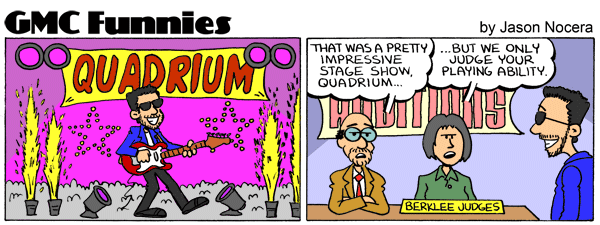Triads, What are those?How to construct a Triad? |
|
|
|
|
|
| Feb 28 2011, 08:29 PM |
|
Hello All.My name is Dogukan Ozturk.Welcome to the another SI Lesson by me.In this lesson i am gonna tell the triad chords,how to construct them.Lets begin,
Chords can be naturally divided into families of related chords based on a particular triad. A triad is a three-note chord that provides a foundation of harmony. Other notes can be added to a triad to form other chords. Many triads are common chords in their own right, while others tend to appear more often as the basis for other chords. The triad is made up of the root, which is the lowest note in the chord, together with the 3rd and 5th above it. If the root is one of the degrees of a major or minor scale then the triads are given Roman numerals or names identifying that degree, in the following way: -I (tonic triad), -II (supertonic triad), -III (mediant triad), -IV (subdominant triad), -V (dominant triad), -VI (submediant triad), -VII (leading note triad) The tonic (I), subdominant (IV) and dominant (V) triads are called primary, the remainder (except that on VII) are called secondary. In addition, the triads are classified according to the quality of the 3rd or 5th; i.e. whether diminished (for 3rd or 5th), major (for 3rd), minor (for 3rd) or augmented (for 3rd or 5th). Lets see how can we construct the basic triad shapes: -A Major Triad consists of root note+major 3rd+perfect 5th of a given scale. -A Minor Triad consists of root note+minor 3rd+perfect 5th of a given scale. -An Augmented Triad consists of root note+major 3rd+augmented 5th of a given scale. -A Diminished Triad consists of root note+minor 3rd+diminished 5th of a given scale. The notes in a triad can be arranged so that the root is no longer the lowest note of the three. If the 3rd is the lowest note, the triad is said to be a 'first inversion' (using Roman notation, denoted by an additional 'b'; e.g. Vb) and when the 5th is the lowest note, the triad is said to be a 'second inversion' (using Roman notation, denoted by an additional c; e.g. Vc). For completeness, the root position may be denoted by an additional 'a'; e.g. Va. Triads where all the notes lie in positions closest to the other notes in the chord, are said to be in 'close' position, otherwise the triads are said to be in 'open' position. Let me summarise the triad harmonisation of the major and minor scales using numbered chords:  Notice the sign in front of III, VI and VII in the natural minor scale. All minor scales are named 'relative' to the major scale on the same key-note. The use of accidental signs in front of numbered chords should be understood to refer to 'raising' or 'lowering' notes in the chord and not necessarily the use of a 'sharp' or 'flat' sign to achieve this. So a 'sharpened' B flat becomes B natural, i.e. 'raised' or 'sharpened' by a semitone. There is one further important point that should be noted. In the major, harmonic minor and melodic minor scales above the triad on the dominants are major (the third is a B natural). The B natural is the leading note to the tonic C and this is the most important factor in the dominant fifth wanting to move to a triad or chord of the tonic. In the natural minor, the dominant triad is minor (the third is a B flat) and the pull to the tonic is much weaker. Only when the third is a major third is the triad on the fifth a dominant triad. And finally lets finish the lesson with an example that showing all the triads of C:  -------------------------------------------------------------------------------------------------------------------------  Hope you enjoy the lesson --------------------  -------------------------------------------------------------------------------------------------------------------------------------------------- SPOTIFY PAGE YOUTUBE CHANNEL |
|
|
||
|
|
|
|
| Mar 28 2011, 05:24 PM |
|
Just added this one to the Knowledge base
https://www.guitarmasterclass.net/wiki/inde...riads_SI_Lesson -------------------- Guitars:
Fender American Deluxe Stratocaster, Ibanez RG2570MZ, Epiphone SG G-400 Amp: Vox AC4TVH head + V112TV cab Effects: Vox Satchurator, Vox Time Machine, Dunlop CryBaby, Boss MT-2, Boss CE-5, Boss TU-2, Boss ME-70 Recording: Line-6 POD X3 + FBV-Express, Pandora PX5D GMC wants YOU to take part in our Guitar-Wikipedia! Have a good time reading great articles and writing your own with us in our GUITAR WIKI! Share your playing and get Pro-advice from our Instructors: Join REC |
|
|
||
|
|
|
|
| Mar 28 2011, 05:41 PM |
|
Just added this one to the Knowledge base https://www.guitarmasterclass.net/wiki/inde...riads_SI_Lesson Thanks Fran --------------------  -------------------------------------------------------------------------------------------------------------------------------------------------- SPOTIFY PAGE YOUTUBE CHANNEL |
|
|
||
1 User(s) are reading this topic (1 Guests and 0 Anonymous Users)
0 Members:





















